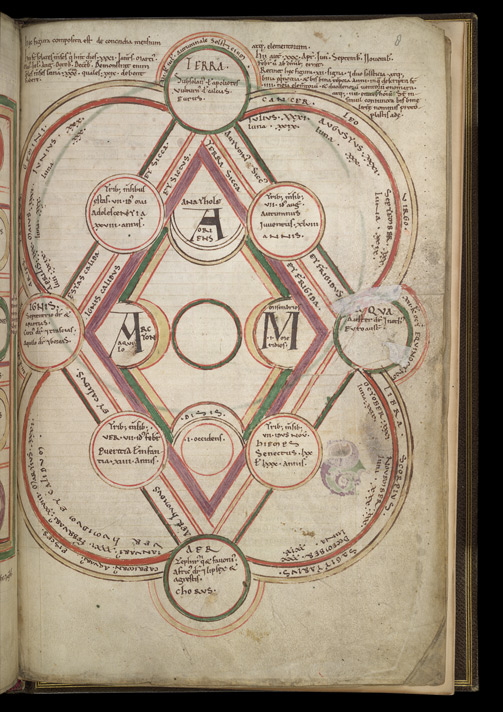Byrhtferth's Diagram, In A Scientific Textbook
 A tradition of natural science books continued in the middle ages from ancient Greek and Roman writings through the early middle ages, when writers such as Isidore of Seville (6th century) and Bede (early 8th century) write treatises on cosmology and calculation of time. Later expanded at Fleury and taken further still by Abbo of Fleury, who lived at Ramsey in the 10th century and was an important intellectual link to the continent, the tradition flourished in Britain’s monasteries. To these natural science books belong a tradition of diagrams which incorporate Christian cosmological doctrine into classical theories on the structure of the heavens and earth, uniting geography, physics and computation of time to demonstrate the harmony of creation. Books such as this one (which is in two separate manuscript fragments in the British Library) would have been textbooks for training monks and churchmen. This book was made at Peterborough, as shown by the annals written on its first pages. Byrhtferth, an Anglo-Saxon monk at Ramsey Abbey, studied under Abbo of Fleury during his stay there. ‘Byrhtferth’s diagram’ is an illustration for his treatise on the computation of the date of Easter and other astrological and natural science topics. It relates many of the ‘foursomes’ of natural science and theology (four ages of man, directions, humours, essences, winds, gospels, etc.) to show the unity of heaven and earth as well as the harmony and truth of scripture.
A tradition of natural science books continued in the middle ages from ancient Greek and Roman writings through the early middle ages, when writers such as Isidore of Seville (6th century) and Bede (early 8th century) write treatises on cosmology and calculation of time. Later expanded at Fleury and taken further still by Abbo of Fleury, who lived at Ramsey in the 10th century and was an important intellectual link to the continent, the tradition flourished in Britain’s monasteries. To these natural science books belong a tradition of diagrams which incorporate Christian cosmological doctrine into classical theories on the structure of the heavens and earth, uniting geography, physics and computation of time to demonstrate the harmony of creation. Books such as this one (which is in two separate manuscript fragments in the British Library) would have been textbooks for training monks and churchmen. This book was made at Peterborough, as shown by the annals written on its first pages. Byrhtferth, an Anglo-Saxon monk at Ramsey Abbey, studied under Abbo of Fleury during his stay there. ‘Byrhtferth’s diagram’ is an illustration for his treatise on the computation of the date of Easter and other astrological and natural science topics. It relates many of the ‘foursomes’ of natural science and theology (four ages of man, directions, humours, essences, winds, gospels, etc.) to show the unity of heaven and earth as well as the harmony and truth of scripture.
© The British Library Board All Rights Reserved
